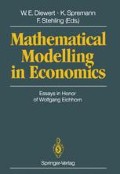Abstract
A framework for assessing a single decision maker’s preference function of several variables is sketched. The preference function is assumed to be additively decomposable into onedimensional preference functions. All attributes are known prior to the given analysis. The case of probability distributions can basically be dealt with in the same way as the case of certainty. However, in the first case we explore an instability phenomenon which does not exist for sure alternatives. The approach is applied to a real world problem in environmental decision making. Preferences serve as a proxy measure for unobtainable statistical data on damage cost and frequency. We describe this application along an outline of a software system developed to cope with that problem.
Preview
Unable to display preview. Download preview PDF.
References
Chew, S.H. (1989), ”Axiomatic utility theories with the betweenness property”, Annals of Operations Research 19, 273–298.
CPLEX Optimization Inc. (1989), ”Using the CPLEX™ linear optimizer”.
Despotis, D.K., Yannacopoulos, D., and Zopounidis, C. (1990), ”A review of the UTA multicriteria method and some improvements”, Foundations of Computing and Decision Science 15, 63–76.
Dyer, J.S. and Sarin, R.K. (1979), ”Measurable multiattribute value functions”, Operations Research 27, 810–822.
Jacquet-Lagrèze, E. and Siskos, J. (1982), ”Assessing a set of additive utility functions for multicriteria decision-making, the UTA method”, European Journal of Operational Research 10, 151–164.
Jacquet-Lagrèze, E., Meziani, R., and Slowinski, R. (1987), ”MOLP with an interactive assessment of a piecewise linear utility function”, European Journal of Operational Research 31, 350–357.
Kämpke, T. (1992), Bestimmung von Präferenzfunktionen mittels linearer und nicht- linearer Optimierungsverfahren, in progress.
Kämpke, T., Radermacher, F.J., and Wolf, P. (1993), ”Supporting preference elicitation”, Decision Support Systems, to appear.
Keeney, R.L. and Raiffa, H. (1976), Decisions with multiple objectives, Wiley, New York.
Wolf, P. (1992), Rechnerunterstützte Elizitierung mehrattributiver Präferenzstrukturen, Dissertation, University of Ulm.
Author information
Authors and Affiliations
Editor information
Editors and Affiliations
Rights and permissions
Copyright information
© 1993 Springer-Verlag Berlin · Heidelberg
About this chapter
Cite this chapter
Kämpke, T., Radermacher, F.J. (1993). Robust Assessment of Preference Functions. In: Diewert, W.E., Spremann, K., Stehling, F. (eds) Mathematical Modelling in Economics. Springer, Berlin, Heidelberg. https://doi.org/10.1007/978-3-642-78508-5_22
Download citation
DOI: https://doi.org/10.1007/978-3-642-78508-5_22
Publisher Name: Springer, Berlin, Heidelberg
Print ISBN: 978-3-642-78510-8
Online ISBN: 978-3-642-78508-5
eBook Packages: Springer Book Archive

